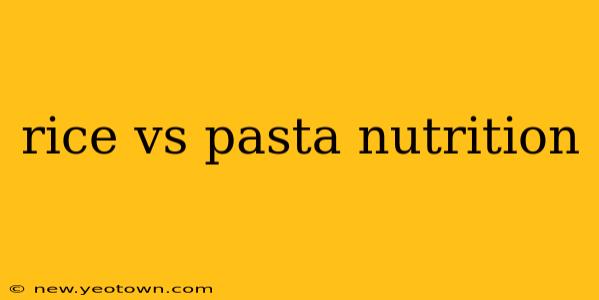The age-old question: rice or pasta? Both are dietary staples across the globe, offering a comforting base for countless meals. But when it comes to nutrition, how do these culinary cornerstones stack up? Let's delve into a detailed comparison, exploring their nutritional profiles and uncovering which might be the better choice for your health goals.
Our culinary journey begins with a look at the nutritional basics of both. We'll explore the differences in carbohydrates, protein, fiber, and micronutrients, unveiling which reigns supreme in each category. We'll also unpack the glycemic index differences and their potential impact on blood sugar levels. Finally, we'll address common concerns around gluten and allergies, helping you make an informed choice for your individual needs.
What are the nutritional differences between rice and pasta?
This is often the first question people ask when comparing these two food groups. The answer isn't a simple "one is better than the other," as the nutritional content varies significantly depending on the type of rice and pasta. White rice, for instance, is significantly lower in fiber and nutrients than brown rice. Similarly, whole wheat pasta boasts a richer nutritional profile compared to its refined counterparts.
Let's look at a general comparison:
Rice (Brown Rice as an Example): Generally a good source of carbohydrates, providing energy. Brown rice, in particular, is a good source of fiber, which aids digestion and promotes satiety. It also contains essential minerals like magnesium and manganese.
Pasta (Whole Wheat Pasta as an Example): Also primarily carbohydrates for energy, but whole wheat pasta offers more fiber and protein than refined pasta. It's a good source of iron and selenium.
To truly understand the differences, one needs to consider the specific type of rice and pasta being consumed. A simple comparison of white rice to whole wheat pasta won't give a complete picture.
Which has more protein?
Both rice and pasta are relatively low in protein compared to other food sources like meat or beans. However, whole wheat pasta generally contains slightly more protein than brown rice. The protein content will vary based on the type and brand of both products.
Which has more fiber?
Fiber is crucial for digestive health. Here, brown rice and whole wheat pasta significantly outperform their refined counterparts. Brown rice is often a richer source of fiber than white rice, and whole wheat pasta contains substantially more fiber than white or refined pasta. This higher fiber content contributes to better digestion and increased feelings of fullness.
Which has a lower glycemic index?
The glycemic index (GI) measures how quickly a food raises blood sugar levels. Foods with a lower GI are generally preferred as they lead to more stable blood sugar levels. Brown rice typically has a lower GI than white rice, and whole wheat pasta usually has a lower GI than refined pasta. Choosing whole grain options is key for better blood sugar control.
Is rice or pasta gluten-free?
This is a crucial question for those with celiac disease or gluten sensitivity. Most rice is naturally gluten-free. However, always check the label to ensure there's no cross-contamination during processing. Pasta, on the other hand, can contain gluten unless specifically made from gluten-free grains like rice, quinoa, or corn.
Which is better for weight loss?
Neither rice nor pasta is inherently "better" for weight loss. The key factor is portion control and the overall nutritional quality of the chosen variety. Whole grain options (brown rice, whole wheat pasta) are generally preferred due to their higher fiber content, which promotes satiety and can aid in weight management. However, consuming excessive amounts of either, even the whole-grain varieties, can lead to weight gain.
What are the health benefits of each?
Rice (Brown Rice): Offers sustained energy, aids digestion (especially brown rice), and provides essential minerals.
Pasta (Whole Wheat Pasta): Supports digestive health, provides sustained energy, and offers some protein and essential minerals.
Ultimately, the "better" choice between rice and pasta depends on your individual dietary needs, preferences, and health goals. Both can be part of a healthy diet, but understanding their nutritional differences empowers you to make informed choices to support your well-being. Remember to choose whole-grain options whenever possible to maximize nutritional benefits.

